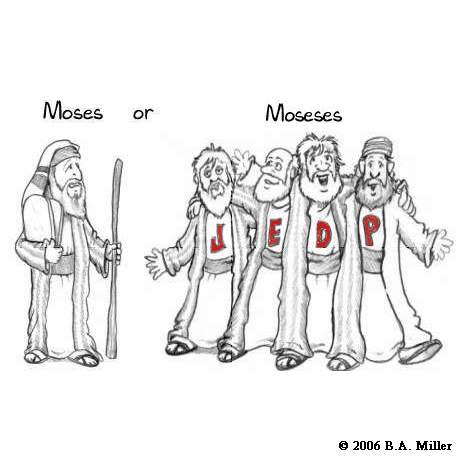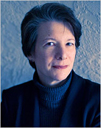
|
|
|
|
|
Class Prep
|
|
|
|
Crafting Our Texts: Literary Issues
 In an earlier class, we discussed the differences between the view of grand narratives in the modern and postmodern periods. We saw that the modern period distrusted religious authorities and revelation, and so replaced religious narratives with new accounts of human history, whether the dialectical materialism of Marx, the evolutionary scheme of Darwin, or the analysis of the individual psyche in Freud. You might think this put biblical scholars out of work, but in fact many of them began to apply the scientific method to the Bible. This took the form of "historical criticism," which our readings this week will explore (form criticism, source criticism, and redaction criticism are forms of this method). In an earlier class, we discussed the differences between the view of grand narratives in the modern and postmodern periods. We saw that the modern period distrusted religious authorities and revelation, and so replaced religious narratives with new accounts of human history, whether the dialectical materialism of Marx, the evolutionary scheme of Darwin, or the analysis of the individual psyche in Freud. You might think this put biblical scholars out of work, but in fact many of them began to apply the scientific method to the Bible. This took the form of "historical criticism," which our readings this week will explore (form criticism, source criticism, and redaction criticism are forms of this method).-
- In the postmodern period, even "scientific" grand narratives have come under suspicion, as we realize that every account we create is influenced by our own interests and perspectives. In biblical studies, this has meant that we have become more critical of our own histories of the text, more aware that they are not objective but interested, and more appreciative of the perspectives of scholars outside the western world and of lay people who may make meaning differently from those who've dominated discussions of the Bible to date. This is also why it has become just as legitimate to study other modes like film, apps, blogs, animation and illumination along with the actual text of the Bible, because we can use these popular modes to appreciate how our culture—and not only authorized scholars—"re-present" and make meaning out of the text. Postmodern concern for us as meaning-makers has also made us more sensitive to the ways that the biblical texts create expectations and gaps so that we as readers are positively invited to make, rather than passively accept, meaning.
-
- Today's reading focuses on how the Bible came together, how diverse its contents are, some of its main literary features, and differences between the Jewish and Christian versions. As you read McKnight and Levine, focus on the following questions:
-
- Identify and define the term Jews use for their Bible and the term used by Christians for those same scriptures. Identify how the order of those books differs and analyze how this difference signals core beliefs of each religion.
- McKnight and Levine speak of how the Hebrew Bible suppresses the motives of characters, prompting readers to question those motives and configure their own for the characters. Identify one example.
- What is source criticism, what textual evidence does it explain, and what does it tell us about how the Torah was put together (see the cartoon above for a prompt)?
-
-
- Assigned Readings
-
- Secondary: Knight & Levine, The Meaning of the Bible chapter 2; online class prep
-
- Slides for Lecture
-
-
- Today's Authors
-
| |
 |
Douglas Knight is the Drucilla Moore Buffington Professor of Hebrew Bible Emeritus and retired Professor of Jewish Studies at Vanderilt University Divinity School in Tenessee. |
| |
 |
Amy-Jill Levine is the University Professor of New Testament and Jewish Studies, the E. Rhodes and Leona B. Carpenter Profesor of New Testament Studies, and Professor of Jewish Studies at Vanderilt University Divinity School in Tenessee. She is a specialist in the Christian Gospel of Matthew and in feminist studies, and is an Orthodox Jew. She will also be our guide through the parables of Jesus when we turn to the New Testament. |
-
-
- Further Reading
-
- Alter, Robert. The Art of Biblical Narrative, rev. and updated. New York: Basic Books, 2011. (our library copy is the original 1981 edition)
-
- Baden, Joel S. The Composition of the Pentateuch: Renewing the Documentary Hypothesis, The Anchor Bible Reference Library. New Haven, Connecticut: Yale University Press, 2012.
-
- Blenkinsopp, Joseph. The Pentateuch: An Introduction to the First Five Books of the Bible, The Anchor Yale Bible Reference Library. New Haven, Connecticut: Yale University Press, 2000.
-
- Boorer, Suzanne. The Vision of the Priestly Narrative: Its Genre and Hermeneutics of Time, Ancient Israel and Its Literature 27. Atlanta: Society of Biblical Literature, 2016.
-
- Friedman, Richard Elliott. The Bible with Sources Revealed. New York: HarperOne, 2005.
-
- --------. Who Wrote the Bible? New York: HarperOne, 1987.
-
- McKenzie, Steven L. and Stephen R. Haynes, ed. To Each Its Own Meaning: An Introduction to Biblical Criticisms and Their Application, rev. and expanded. Louisville: Westminster John Knox Press, 1999.
-
- Satlow, Michael L. How the Bible Became Holy. New Haven, Connecticut: Yale University Press, 2014.
-
- Simon, Ed. "Let There Be Light: Handwritten Draft of King James Bible Reveals Secrets of Its Creation." Religion Dispatches (19 October 2015). Online, http://religiondispatches.org/let-there-be-light-handwritten-draft-of-king-james-bible-reveals-secrets-of-its-creation/, accessed 19 October 2015.
-
- Sweeney, Marvin A. Tanak: A Theological and Critical Introduction to the Jewish Bible. Minneapolis: Fortress, 2011.
-
-
- Links
-
- Bible Odyssey - A resource of reference materials in plain English by biblical scholars, maintained by the Society of Biblical Literature. Look up "Documentary Hypothesis" or "historical criticism" to learn more about today's topics. This is a great resource to know about for the whole quarter.
-
-
- Acknowledgements
-
- Cartoon by B. A. Miller, 2006. Downloaded from Stephen Smoot, "J, E, D, P, and Me: Some Thoughts on the Documentary Hypothesis," blogpost from Ploni Almoni ~ Mr. So-and-So's Mormon Blog (28 February 2014), online, http://www.plonialmonimormon.com/2014/02/jedp-and-me-some-thoughts-on.html, accessed 23 July 2015.
|
|
|
|
|
